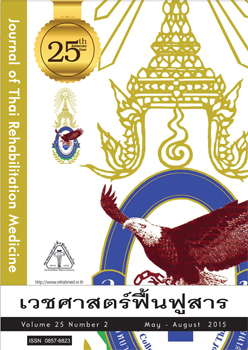ความเที่ยงและความตรงของเครื่องมือวัดคุณภาพชีวิต Stroke Impact Scale (SIS) 3.0 ฉบับภาษาไทย
Keywords:
คุณภาพชีวิต, Stroke Impact Scale (SIS), ความเที่ยง, ความตรง, ฉบับแปลภาษาไทย, quality of life, validity, reliability, Thai versionAbstract
Reliability and Validity of the Thai Version of the Stroke Impact Scale (SIS) 3.0
Garnjanagoonchorn A and Dajpratham P
Department of Rehabilitation Medicine, Faculty of Medicine Siriraj Hospital
Objectives: To assess reliability and validity of the Thai version of the Stroke Impact Scale (SIS) version 3.0
Study design: Descriptive study
Setting: Department of Rehabilitation Medicine, Siriraj Hospital
Subjects: Stroke patients attending at Siriraj Hospital, from December 2012 to July 2013.
Methods: Sixty subjects were assessed with the SIS 3.0 Thai version. The criterion validity was examined by comparing the SIS to the standard measurements for stroke; Barthel Index (BI),Thai Mental State Examination (TMSE),Functional Ambulation Categories (FAC), Patient Health Questionnaires (PHQ-9) and was analyzed by using Spearman’s correlation coefficient. The discriminant validity of the SIS was examined by one way ANOVA and Bonferroni method among stroke patients with different levels of disabilities divided by Modified Rankin Scale (MRS). The reliability was examined by intraclass correlation and Cronbach’s alpha coeffecients for test-retest reliability and internal consistency respectively.
Results: Thirty-three males (55%) and mean age 63 (SD=10.9) years old were recruited. The validity of each domain was compared with the standard outcome measurements and showed moderated to good correlations for emotion (0.54), social participation (0.53-0.68), ADL/IADL (0.73-0.75), and mobility (0.74-0.76) domains. The strength (0.41-0.43) and communication (0.4) domains showed fair correlations whilst memory (0.25), and hand function (0.19-0.25) domains showed little correlations. The discriminant validity across different levels was significant in composite physical, social participation, mobility, ADL/IADL, strength, and communication domains including percentage of recovery. The test-retest reliability of SIS domains were indicated excellent reproducibility and ranged from 0.92 to 0.99.The internal consistency ranged from 0.7 to 0.9 except the emotion domain (0.5).
Conclusion: The Thai version of the Stroke Impact Scale (SIS) version 3.0 showed good test-retest reliability. The validity was acceptable and could be used in stroke survivors to assess health-related quality of life.
บทคัดย่อ
วัตถุประสงค์: เพื่อทำการวิเคราะห์หาความเที่ยงและความ ตรงของ เครื่องมือวัดคุณภาพชีวิต Stroke Impact Scale (SIS) ฉบับแปลภาษาไทย
รูปแบบการวิจัย: การวิจัยเชิงพรรณนา
สถานที่ทำการวิจัย: ภาควิชาเวชศาสตร์ฟื้นฟู โรงพยาบาล ศิริราช
กลุ่มประชากร: ผู้ป่วยโรคหลอดเลือดสมองที่มารับการรักษา โรงพยาบาลศิริราช ตั้งแต่ ธ.ค. 2555-ก.ค. 2556
วิธีการศึกษา: ผู้ป่วย 60 คน ได้รับการประเมินคุณภาพชีวิต ด้วยแบบสอบถาม SIS ฉบับแปลภาษาไทย ตรงความเชิงเกณฑ์ ของเครื่องมือประเมินจากความสัมพันธ์ของคะแนน Barthel Index (BI),Thai Mental State Examination (TMSE), Functional Ambulation Categories (FAC), Patient Health Questionnaires (PHQ-9) และคะแนนจากแบบสอบถาม SIS ในด้านที่เกี่ยวข้อง และทำการวิเคราะห์ข้อมูลด้วยวิธี Spearman’s correlation coefficient ความตรงเชิงการจำแนก โดยเปรียบเทียบคะแนนของแบบสอบถาม SIS ระหว่างกลุ่มที่ มีระดับความพิการจำแนกตาม MRS วิเคราะห์ข้อมูลด้วยวิธี 1- way ANOVA และ Bonferroni ส่วนความเที่ยงของเครื่องมือแบบวิธีถามซ้ำ วิเคราะห์ข้อมูลด้วยวิธี Intraclass Correlation และความเที่ยงด้านความสอดคล้องภายใน วิเคราะห์ด้วยวิธี Cronbach’s Alpha coefficient
ผลการศึกษา: ผู้ชาย 33 คน (55%) และอายุเฉลี่ย 63 ปี (+10.9) ได้รับการประเมินด้วยแบบสอบถาม SIS ฉบับภาษา ไทย ค่าความตรงเชิงเกณฑ์ของแบบสอบถาม SIS ฉบับแปล ภาษาไทย เมื่อเปรียบเทียบกับแบบวัดมาตรฐานที่เกี่ยวข้อง พบว่า มีความสัมพันธ์ระดับดีกับการเคลื่อนไหวร่างกาย (0.74- 0.76), การใช้ชีวิตประจำวัน (0.73-0.75), การมีส่วนร่วมใน กิจกรรมทางสังคม (0.53-0.68) และอารมณ์ความรู้สึก (0.54) มีความสัมพันธ์ระดับปานกลางกับความแข็งแรงของร่างกาย (0.41-0.43) และการสื่อสาร (0.4) มีความสัมพันธ์ระดับต่ำกับ ความจำและความคิด (0.25) และการทำงานของมือ (0.19- 0.25) ค่าความตรงเชิงการจำแนกของ SIS ในกลุ่มผู้ป่วยที่มี ระดับความพิการต่างกันตาม MRS พบว่ามีนัยสำคัญทางสถิติ ในด้านร่างกายโดยรวม, การมีส่วนร่วมในกิจกรรมทางสังคม, การเคลื่อนไหวร่างกาย, การใช้ชีวิตประจำวัน และการสื่อสาร รวมทั้งการให้คะแนนการฟื้นตัวด้วยตัวเอง ส่วนค่าความเที่ยง ของเครื่องมือแบบวิธีถามซ้ำอยู่ในระดับดีมาก (0.92-0.99) ความเที่ยงด้านความสอดคล้องภายในอยู่ในเกณฑ์ยอมรับได้ ทุกรายด้าน (0.7-0.9) ยกเว้นด้านอารมณ์ความรู้สึก (0.5)
สรุป: เครื่องมือวัดคุณภาพชีวิต SIS ฉบับภาษาไทยมีความ เที่ยงและความตรง สามารถนำมาใช้ประเมินคุณภาพชีวิต ผู้ป่วยโรคหลอดเลือดสมองได้






